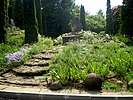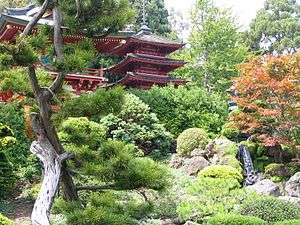Rock garden
A rock garden, also known as a rockery or an alpine garden, is a small field or plot of ground designed to feature and emphasize a variety of rocks, stones, and boulders.

The standard layout for a rock garden consists of a pile of aesthetically arranged rocks in different sizes, with small gaps between in which plants are rooted. Typically, plants found in rock gardens are small and do not grow larger than 1 meter in height,[1] though small trees and shrubs up to 6 meters may be used to create a shaded area for a woodland rock garden. If used, they are often grown in troughs or low to the ground[2] to avoid obscuring the eponymous rocks. The plants found in rock gardens are usually species that flourish in well-drained, poorly irrigated soil.
Some rock gardens are designed and built to look like natural outcrops of bedrock. Stones are aligned to suggest a bedding plane, and plants are often used to conceal the joints between said stones. This type of rockery was popular in Victorian times and usually created by professional landscape architects. The same approach is sometimes used in commercial or modern-campus landscaping but can also be applied in smaller private gardens.
The Japanese rock garden, often referred to as a "Zen garden", is a special kind of rock garden with water features, moss, pruned trees and bushes, and very few plants.
Rock gardens have become increasingly popular as landscape features in tropical countries such as Thailand.[3] The combination of wet weather and heavy shade trees, along with the use of heavy plastic liners to stop unwanted plant growth,[4] has made this type of arrangement ideal for both residential and commercial gardens due to its easier maintenance and drainage.[5]
History
Although the use of rocks as decorative and symbolic elements in gardens can be traced back to early Chinese and Japanese gardens, rock gardens dedicated to growing alpine plants have a shorter history.
During the Golden Age of Botany (early 1700s – mid-1800s), there was widespread interest in exotic articles imported to England. Although others had previously written about growing alpine plants, it was Reginald Farrer that started this tradition with the 1919 publication of his two-volume book, The English Rock Garden.
Gallery
 Japanese rock garden, A mountain, waterfall, and gravel "river" at Daisen-in (1509–1513)
Japanese rock garden, A mountain, waterfall, and gravel "river" at Daisen-in (1509–1513) Pool in rock garden on Edmonton campus of University of Alberta, Edmonton, Alberta, Canada.
Pool in rock garden on Edmonton campus of University of Alberta, Edmonton, Alberta, Canada. Small rockery in the Iaşi Botanical Garden, Romania
Small rockery in the Iaşi Botanical Garden, Romania Kew Rock garden, Kew Gardens
Kew Rock garden, Kew Gardens Hagiwara Japanese Tea Garden, a tea garden in San Francisco
Hagiwara Japanese Tea Garden, a tea garden in San Francisco
See also
- List of garden types
- Gardening
- Garden design
- Rock Garden, Chandigarh in Chandigarh, India
- Nek Chand, creator of the Rock Garden in Chandigarh, India.
References
- "Rock Gardening: plants". Royal Horticulture Society. Retrieved 21 March 2016.
- "Sink and trough gardening". Royal Horticulture Society. Retrieved 21 March 2016.
- Warren, William (1996). Thai Garden Style. Singapore: Asia Books Co., Ltd.
- "Thai Rock Gardens". Thai Garden Design. Retrieved 12 February 2013.
- "Plant Maintenance a Pain? Stone Gardens Are the Way To Go!". Thai Garden Design. Retrieved 12 February 2013.
External links
| Wikimedia Commons has media related to Rock gardens. |

